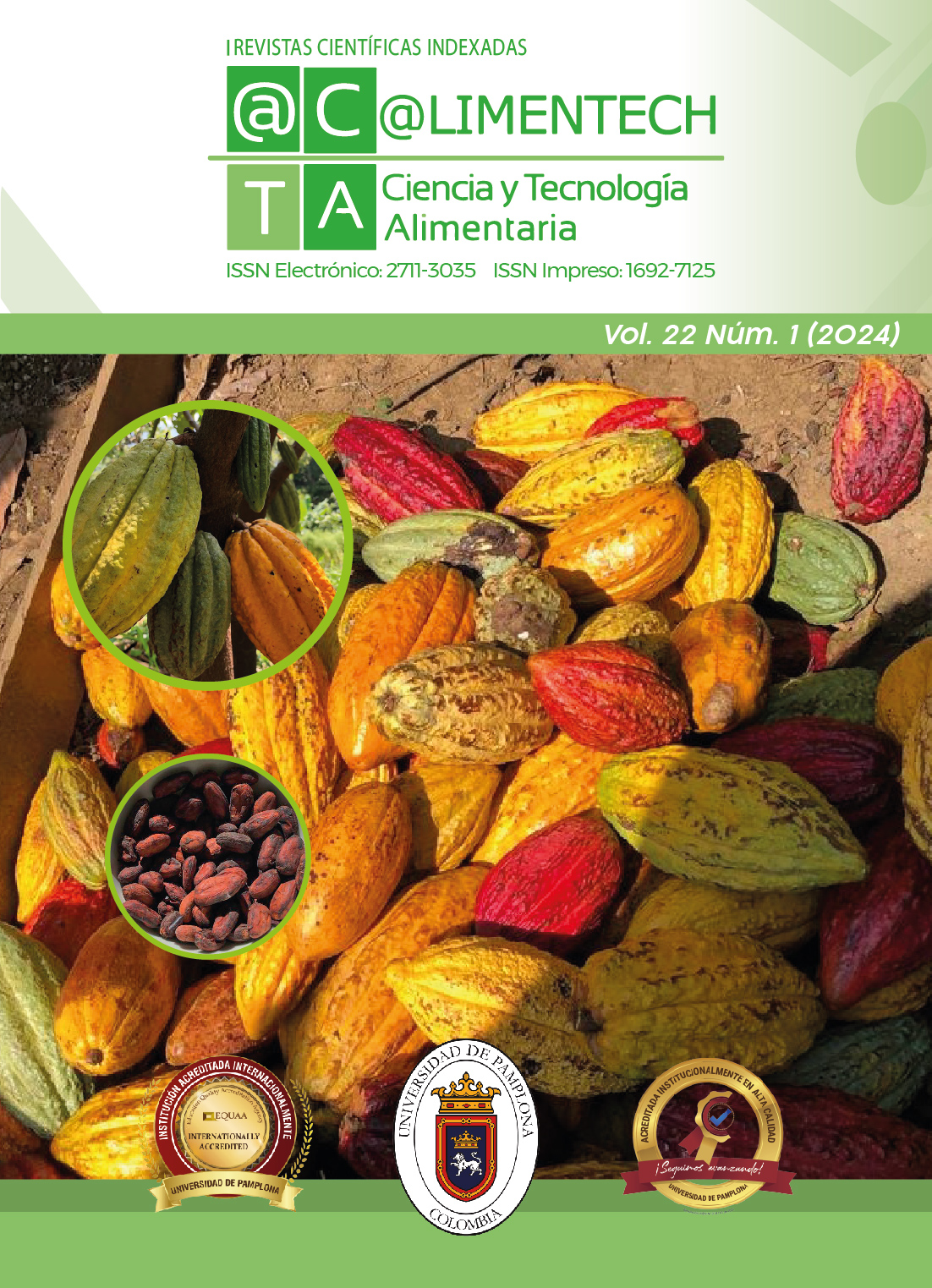Optimization of acetic acid Yield by gluconobacter oxydans using a Box-Behnken design
DOI:
https://doi.org/10.24054/limentech.v22i1.3184Keywords:
acetic acid bacteria, dairy wastewater, response surface methodologyAbstract
This study aims to optimize acetic acid (AA) production by Gluconobacter oxydans using a culture medium modified with dairy wastewater, applying a Box-Behnken design. The independent variables evaluated were glucose concentration, temperature (°C), and incubation time (hours). The resulting regression model demonstrated that temperature and incubation time were statistically significant factors influencing AA yield. Optimal conditions for maximum AA production were determined to be 33.484°C, 5.030% (v/w) glucose concentration, and 70.565 hours of incubation, yielding a predicted AA concentration of 4.763 g/100 mL. The relationships among these variables were modeled with a precision exceeding 91.58%, underscoring the robustness and reliability of the predictions. This optimized approach provides a sustainable method for AA production while repurposing dairy wastewater, contributing to a circular economy framework.
Downloads
References
De Roos, J. y de Vuyst, L. (2018). Acetic acid bacteria in fermented foods and beverages. Current Opinion in Biotechnology, 49, 115–119. https://doi.org/10.1016/J.COPBIO.2017.08.007.
Dai, L., Jiang, W., Jia, R., Zhou, X. y Xu, Y. (2022). Directional enhancement of 2-keto-gluconic acid production from enzymatic hydrolysate by acetic acid-mediated bio-oxidation with Gluconobacter oxydans. Bioresource Technology, 348, 126811. https://doi.org/10.1016/j.biortech.2022.126811.
González Cuello, R., Ortega Toro, R. y Taron Dunoyer, A. (2024). LIMENTECH CIENCIA Y TECNOLOGÍA ALIMENTARIA. Volumen 22 No. 1, P. 282 - 294. Facultad de Ingenierías y Arquitectura, Universidad de Pamplona.
Ding, H., Li, J., Gao, Y., Zhao, D., Shi, D., Mao, G., Liu, S. y Tan, X. (2015). Preparation of silica nanoparticles from waste silicon sludge. Powder Technology, 284, 231–236. https://doi.org/10.1016/j.powtec.2015.06.063.
Es-Sbata, I., Castro, R., Carmona, Y., Zouhair, R. y Durán, E. (2022). Influence of different bacteria inocula and temperature levels on the chemical composition and antioxidant activity of prickly pear vinegar produced by surface culture. Foods, 11(3), 303-323. https://doi.org/10.3390/foods11030303.
Fasolo, D., Pippi, B., Meirelles, G., Zorzi, G., Fuentefria, A.M., Poser, G. y Teixeir, H.F. (2020). Topical delivery of antifungal Brazilian red propolis benzophenones-rich extract by means of cationic lipid nanoemulsions optimized by means of Box-Behnken design. Journal of Drug Delivery Science and Technology, 56, 101573. https://doi.org/10.1016/j.jddst.2020.101573.
Gibbins, R.D., Aksoy, H.A. y Ustun, G. (2012). Enzyme-assisted aqueous extraction of safflower oil: optimization by response surface methodology. International Journal of Food Science and Technology, 47, 1055–1062. https://doi.org/10.1111/j.1365-2621.2012.02940.x.
Gullo, M., Caggia, C., De Vero, L. y Giudici, P. (2006). Characterization of acetic acid bacteria in “traditional balsamic vinegar.” International Journal of Food Microbiology, 106(2), 209–212. https://doi.org/10.1016/j.ijfoodmicro.2005.06.024.
Kalck, P., Le Berre, C. y Serp, P. (2020). Recent advances in the methanol carbonylation reaction into acetic acid. Coordination Chemistry Reviews, 402(1), 213078. https://doi.org/10.1016/j.ccr.2019.213078.
Mamlouk, D. y Gullo, M. (2013). Acetic Acid Bacteria: Physiology and Carbon Sources Oxidation. Indian Journal of Microbiology, 53(4), 377–384. https://doi.org/10.1007/s12088-013-0414-z.
Pal, P. y Nayak, J. (2016). Acetic acid production and purification: critical review towards process intensification. Separation and Purification Reviews, 46(1). https://doi.org/10.1080/15422119.2016.1185017.
Seraman, S., Rajendran, A. y Thangavelu, V. (2010). Statistical optimization of anticholesterolemic drug lovastatin production by the red mold Monascus purpureus. Food Bioprod. Process, 88, 266–276. https://doi.org/10.1016/j.fbp.2010.01.006.
Sharafi, S.M., Rasooli, I. y Beheshti-Maal, K. (2010). Isolation, characterization, and optimization of indigenous acetic acid bacteria and evaluation of their preservation methods. Iranian Journal of Microbiology, 2(1), 38-45. https://pubmed.ncbi.nlm.nih.gov/22347549/.
Tarón-Dunoyer, A., González-Cuello, R. y Ortega-Toro, R. (2023). Modeling the growth of spoilage bacteria in costeño cheese subjected to thermosensation. Revista @limentech, Ciencia y Tecnología Alimentaria. Volumen 21 N° 2, Pp: 22-35.
Upadhyay, A., Kovalev, A., Zhuravleva, E., Pareek, N. y Vivekanand, V. (2023). Enhanced production of acetic acid through bioprocess optimization employing response surface methodology and artificial neural network. Bioresource Technology, 376, 128930. https://doi.org/10.1016/j.biortech.2023.128930.
Villegas-Duran, M., González-Cuello, R. y Taron-Dunoyer, A. (2023). Effect of high and low acyl gellan on growth parameters of Lactobacillus Delbrueckii. Revista @limentech, Ciencia y Tecnología Alimentaria. Volumen 21 N° 2, Pp: 57-68.
Wang, L., Lei, Z., Zhang, Z., Shimizu, K., Yuan, T., Li, S. y Liu, S. (2022). Insight into enhanced acetic acid production from food waste in anaerobic hydrolysis/acidification with Fe3O4 supplementation. Waste Management, 150, 310–319. https://doi.org/10.1016/j.wasman.2022.07.019.
Zhao, G., Zhao, S., Hagner Nielsen, L., Zhou, F., Gu, L., Tilahun Tadesse, B. y Solem, C. (2023). Transforming acid whey into a resource by selective removal of lactic acid and galactose using optimized food-grade microorganisms. Bioresource Technology, 387, 129594. https://doi.org/10.1016/J.BIORTECH.2023.129594.
Downloads
Published
Versions
- 2024-06-30 (2)
- 2024-06-30 (1)





